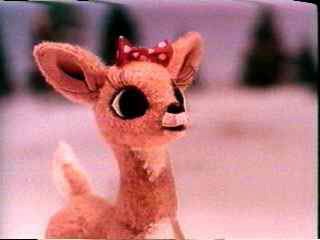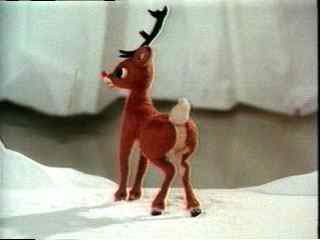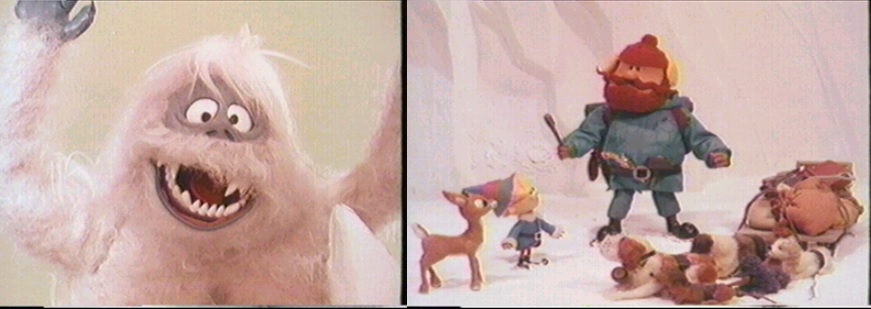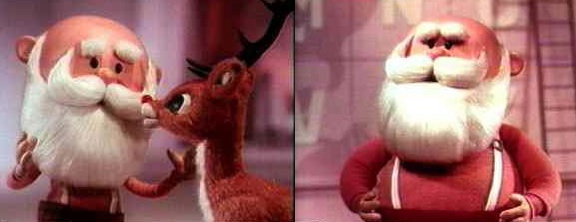Rudolph the Red-nosed Reindeer and the Power of Myth
Bill Moyers introduced Dr. Joseph Campbell to the “general public” in the 1988 PBS series the Power of Myth. Campbell dazzled the audience with exotic mythological tales as well as the fundamental similarities among the world’s seemingly diverse traditions. The interviews revealed Campbell’s’s life-long quest to understand the human experience. He is most famous for his model of a hero which his published works explain in detail: The Hero with A Thousand Faces, 1949; The Masks of God, 4 Volumes, 1959. Myths speak to the experience of “life” or the power of the universe. Campbell explained that life is a journey taken by a hero (Gilgamesh, Moses, Jesus, Buddha) and follows a predictable pattern–departure (birth), struggle/fulfillment (death), and return (rebirth). The hero provides ordinary humans with guidelines of how to succeed on the journey, from childhood through adolescence to maturity. The old-self must die before the new-self can emerge.
Campbell lamented the absence of myth in the contemporary world, but he simply looked in the wrong place. Most academicians look down on popular culture and even dismiss cartoons as children’s entertainment. Remember, however, that Homer’s Iliad did not begin as the object of professorial study. The 1964 animated television program Rudolph the Red-nosed Reindeer provides a wonderful example of a hero and of an American myth which continues to touch millions of children each year. On the surface it tells the simple story of a reindeer who saved Christmas. I think it gained widespread popularity, however, because on a deeper level it touched on the major issues of the civil rights movement with elegance and directness. The hero pattern conveyed the message of racial and political cooperation in a sublime fashion, moving the hearts and minds of countless children and their parents. Campbell’s model then provides a thesis and the outline for analyzing Rudolph.
Campbell’s model of a hero begins with the departure. The hero must leave his family and friends behind. Our hero, Rudolph, must leave Christmas Town, a paradise in the minds of most children and its inhabitants. Rudolph, however, was born with a red nose . His proud fa ther, Santa’s lead reindeer Donner, was embarrassed by his son’s imperfection. Mrs. Donner tried to allay his disappointment by saying the nose could be overlooked. Unfortunately, Santa arrived and confirmed Donner’s first reaction. After initially calling Rudolph a sturdy and smart fawn, Santa too expressed his disappointment that such a promising young reindeer had a glowing red nose. The not so subtle message is that Rudolph’s red nose some how transformed him into a “bad” reindeer. Donner responded by hiding the nose with an uncomfortable mud cover. During the first year of Rudolph’s life, the ruse worked well–that is until the annual reindeer games.
ther, Santa’s lead reindeer Donner, was embarrassed by his son’s imperfection. Mrs. Donner tried to allay his disappointment by saying the nose could be overlooked. Unfortunately, Santa arrived and confirmed Donner’s first reaction. After initially calling Rudolph a sturdy and smart fawn, Santa too expressed his disappointment that such a promising young reindeer had a glowing red nose. The not so subtle message is that Rudolph’s red nose some how transformed him into a “bad” reindeer. Donner responded by hiding the nose with an uncomfortable mud cover. During the first year of Rudolph’s life, the ruse worked well–that is until the annual reindeer games.
Each spring the yearlings gathered to play games designed to help them make Santa’s elite team of reindeer. Immediately, Rudolph made friends with another young buck named “Fireball.” Fireball explained to Rudolph that the games also provided an opportunity to show off in front o f the young does. While he waited his opportunity to demonstrate his flying skills to Santa, Clarice caught Rudolph’s eye. Encouraged by Fireball, Rudolph introduced himself. When Rudolph left Clarice to return to the games, she agreed to walk home with him and told him he was cute. Rudolph, like any young male, felt his heart throb and jump for joy. He leapt into the air, giving the crowd a fine example of flying ability. Returning to the ground, he began sparring with Fireball. To the shock of all around him, Rudolph lost his nose cover. The young male reindeer taunted him, and Clarice’s father ordered his daughter to stay away from the freak. Even Santa abandoned Rudolph, even though he had clearly shown the most promise as a flier, saying, “Donner you should be ashamed of yourself. He had a nice takeoff too.”
f the young does. While he waited his opportunity to demonstrate his flying skills to Santa, Clarice caught Rudolph’s eye. Encouraged by Fireball, Rudolph introduced himself. When Rudolph left Clarice to return to the games, she agreed to walk home with him and told him he was cute. Rudolph, like any young male, felt his heart throb and jump for joy. He leapt into the air, giving the crowd a fine example of flying ability. Returning to the ground, he began sparring with Fireball. To the shock of all around him, Rudolph lost his nose cover. The young male reindeer taunted him, and Clarice’s father ordered his daughter to stay away from the freak. Even Santa abandoned Rudolph, even though he had clearly shown the most promise as a flier, saying, “Donner you should be ashamed of yourself. He had a nice takeoff too.”
Rejected by his family and friends, banned from playing reindeer games, Rudolph wandered away from the crowd. On the way out of Christmas Town he met Hermey, the elf who wanted to be a dentist. Hermey’s desire had threatened to break the most basic traditions of the community; whoever heard of an elf who did not like to make toys and wanted to study. These two misfits, one physical and the other political, made quite a pair. They decided to run away (a common impulse for young children, and even some parents of young children) to seek fame and fortune. The departure act ended when they crossed a log which immediately fell into a deep ravine. There was no turning back.
The action then shifted to the struggle or fulfillment stage of the journey. Rudolph and Hermey entered the outside world, a world that “is up to its ears in danger.” Along the way they confronted a mythic beast, the abominable snow monster: “He’s mean, he’s nasty, and he hates everything to do with Christmas.” Not only was this monster a threat to all travelers, but it was also attracted to the light of Rudolph’s red nose, further confirming the young buck’s insecurities. Fortunately, as Campbell explained, all heros find help along their journey. Rudolph and Hermey found Yukon Cornelius. Yukon, the greatest prospector of the North, had experience with the snow monster and successfully removed the two from any immediate danger. Unfortunately, Yukon set all three of them adrift on a sheet of ice which floated across a vast sea and did not come to rest until the travelers were in a strange world. Rudolph, Hermey and Yukon soon discovered that they had crossed the threshold, to land on the Island of Misfit Toys (the underworld in traditional mythology).
The whole island was inhabited by toys children rejected because some had physical disabilities while others simply did not conform to social norms. All of the toys had unusual designs, for example a Charlie in the Box, a Choo-choo with square wheels on the Caboose, a Spotted Elephant and a Cowboy riding an Ostrich (I think this last toy would be particularly out of place here in Texas). Rudolph and Hermey decided that they had found a place to call home and wanted to petition King Moonracer, the flying lion who collected all of the unloved toys, to remain on the island. The lord of the underworld rejected their request, telling them that living beings cannot hide themselves on an island. He counseled them to return to Christmas Town.
Forced to leave the island, but failing to heed Moonracer’s wise counsel, the three adventurers made plans to recross the sea. Yukon and Hermey insisted on traveling as a group. Rudolph did not accept this plan. Fearing his nose would put his only friends in danger, the young reindeer slipped off the island of misfit toys without Yukon and Hermey. During the course of the next year, Rudolph wandered the wilderness, and even though he stopped and made friends, the friendships never lasted. He did, however, begin to change. He grew a set of antlers, a physical  transformation which symbolized his spiritual growth. Two days before Christmas he decided to return home. To his dismay he found that his father, mother and Clarice had all gone looking for him. The situation was made worse by an approaching storm–the “Storm of Storms.” The young reindeer’s rash actions not only put his loved ones in danger but also threatened Christmas. Without Donner, Santa’s sleigh would never get off the ground. Rudolph’s journey into the wilderness began once again. He had to find his parents and sweetheart before they were lost forever.
transformation which symbolized his spiritual growth. Two days before Christmas he decided to return home. To his dismay he found that his father, mother and Clarice had all gone looking for him. The situation was made worse by an approaching storm–the “Storm of Storms.” The young reindeer’s rash actions not only put his loved ones in danger but also threatened Christmas. Without Donner, Santa’s sleigh would never get off the ground. Rudolph’s journey into the wilderness began once again. He had to find his parents and sweetheart before they were lost forever.
Unlike the first part of his struggle, this time Rudolph could not hide from his problems. His search took him to the cave of the abominable snow monster which had captured the three tasty reindeer. Rudolph, rising to the challenge, charged the monster. His efforts seemed to have failed as he lay unconscious under the huge creature. Yukon and Hermey, who had refused to abandon their reckless friend, approached the mouth of the cave and devised a plan. While Hermey squealed like a pig to attract the attention of the monster, Yukon readied himself atop the entrance to the cave. The trick successfully turned the monster’s attention away from the reindeer to the imaginary pig. As the beast emerged, Yukon sent an avalanche down on the creature’s head. Hermey then used his extraordinary skills as a dentist to remove the monster’s teeth.
 Our triumphant hero, his family and friends returned to their community and relayed their hard learned lesson: misfits do have a place in society. They challenged their fellow citizens of Christmas Town to confront their prejudices. Even Santa, that jolly old fellow, renounced his prejudice and acknowledged his willingness to tolerate Rudolph’s “imperfection.” The head elf also repented and granted Hermey permission to set up a dentist office. The merry welcome was interrupted by the entrance of the abominable snow monster. Now toothless, the monster found his place in society by setting the star on the top of the Christmas tree–without a ladder. What a miraculous turn of events.
Our triumphant hero, his family and friends returned to their community and relayed their hard learned lesson: misfits do have a place in society. They challenged their fellow citizens of Christmas Town to confront their prejudices. Even Santa, that jolly old fellow, renounced his prejudice and acknowledged his willingness to tolerate Rudolph’s “imperfection.” The head elf also repented and granted Hermey permission to set up a dentist office. The merry welcome was interrupted by the entrance of the abominable snow monster. Now toothless, the monster found his place in society by setting the star on the top of the Christmas tree–without a ladder. What a miraculous turn of events.
But this did not end the story. Santa had decided to cancel Christmas because of the “worst storm” in history . When he made the announcement, he told Rudolph to tone his nose down. Then Santa had a revelation: “Oh that beautiful, wonderful nose. … Rudolph, with your nose so bright, won’t you guide my sleigh tonight.” The misfit saved Christmas. Donner turned to his wife and said “I knew it all along.” At this point Santa himself was transformed. All through the story Mrs. Clause had chastised her husband for being too skinny. Now that his mental outlook had changed, Santa could return to normal. As leader of Santa’s sleigh team, Rudolph brought the jolly old man to the Island of Misfit Toys. Santa decided to find children with hearts big enough to accept them. These children were there all the time, but no one cared enough, not even Santa, to consider the plight of the misfits tucked neatly away out of sight.
Every year a new group of American children sit down in front of the television and watch “Christmas stories.” These stories, however, have little to do with Christian religion. Rather, using mythological images and models, they profess some of the fundamental principles of American secular culture. Television producers transformed Rudolph the Red-nosed Reindeer from an originally written 1930s short story into an enduring myth which addressed the prevailing issues of late twentieth century America. Tolerance of racial and political differences is no longer good enough. If society is going to work harmoniously, no citizen can be denied the opportunity to contribute his or her gifts. In the beginning of the myth Rudolph’s nose was a threat to his family and friends, but in the end the community saw his uniqueness as its salvation. This message is just as profound as any found in “scripture,” yet scholars usually steer clear of television programs as source material. I hope that I have convinced you that a broader definition of “culture” opens up new avenues of study. If I have not convinced you, just remember the last line of the song . . . “Rudolph the Red-nosed Reindeer you’ll go down in history.”
Comments
You must be logged in to post a comment.

